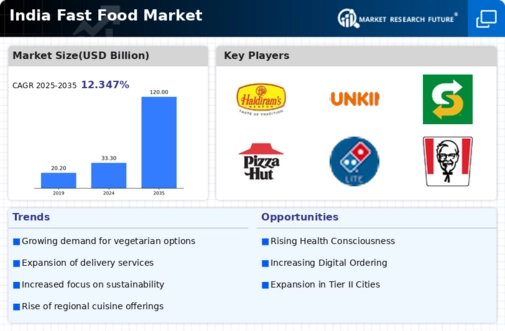Youth Demographics
India's demographic profile is characterized by a significant youth population, which plays a crucial role in shaping the fast food market. Approximately 50% of the Indian population is under the age of 25, and this demographic is particularly inclined towards fast food consumption. The fast food market is adapting its offerings to cater to the tastes and preferences of younger consumers, who often seek innovative and trendy food options. This age group is also more likely to engage with digital platforms for food ordering, further enhancing market growth. As a result, fast food chains are increasingly focusing on marketing strategies that resonate with the youth, including social media campaigns and collaborations with influencers. The potential for growth in this segment is substantial, as the youth demographic continues to expand and evolve.
Cultural Adaptation
The fast food market in India is characterized by its ability to adapt to local tastes and cultural preferences. Unlike many Western markets, Indian consumers have unique dietary restrictions and preferences, which necessitate a tailored approach. Fast food chains are increasingly offering vegetarian options and regional flavors to cater to diverse consumer needs. For instance, the introduction of paneer-based dishes and spicy variants has proven successful in attracting a wider audience. This cultural adaptation not only enhances customer satisfaction but also fosters brand loyalty. As the market continues to evolve, the ability to innovate and incorporate local ingredients will likely play a pivotal role in the growth of the fast food market. The ongoing trend of fusion cuisine further exemplifies this adaptability, as brands experiment with blending traditional Indian flavors with fast food concepts.
Rising Urbanization
The fast food market in India is experiencing a notable surge due to rapid urbanization. As more individuals migrate to urban areas, the demand for convenient dining options increases. Urban centers are witnessing a rise in disposable incomes, leading to a shift in consumer preferences towards fast food. According to recent data, urban households are spending approximately 30% more on dining out compared to rural households. This trend indicates a growing appetite for fast food, as busy lifestyles necessitate quick meal solutions. The fast food market is thus capitalizing on this urban migration, with new outlets opening in metropolitan areas to cater to the increasing population. Furthermore, the expansion of infrastructure and transportation networks in cities facilitates easier access to fast food establishments, further driving growth in the market.
Technological Advancements
The fast food market in India is witnessing a transformation driven by technological advancements. The proliferation of smartphones and internet access has revolutionized the way consumers interact with fast food brands. Online ordering and delivery services have become increasingly popular, with a reported growth of 25% in online food delivery in recent years. Fast food chains are leveraging technology to enhance customer experience, offering mobile apps for easy ordering and payment. Additionally, the use of data analytics allows companies to better understand consumer preferences and tailor their offerings accordingly. This technological integration not only streamlines operations but also fosters customer loyalty, as convenience becomes a key factor in dining choices. The fast food market is thus positioned to benefit from these innovations, potentially leading to increased sales and market share.
Increasing Health Consciousness
While the fast food market is often associated with unhealthy eating habits, there is a growing trend towards health consciousness among Indian consumers. Many fast food chains are responding to this shift by introducing healthier menu options, such as salads, whole grain wraps, and low-calorie beverages. Recent surveys indicate that nearly 40% of consumers are actively seeking healthier alternatives when dining out. This trend is particularly evident in urban areas, where health awareness is on the rise. Fast food establishments that adapt to these changing preferences may find themselves at a competitive advantage. The incorporation of nutritional information on menus and the promotion of healthier choices could potentially attract a broader customer base, thereby enhancing the overall growth of the fast food market.






















Leave a Comment